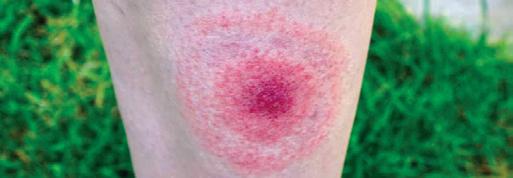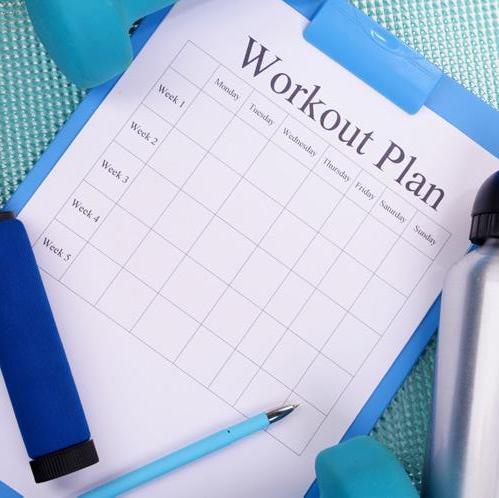
10 minute read
Keep a close eye on your
from May 28 edition
People are taking special precautions to avoid becoming vulnerable to COVID-19 by wearing masks and gloves in public places. However, outdoor social distances can carry their own risks.
Beaches and parks have become popular places of social distance to help prevent the spread of coronaviruses. Many people are really focused on doing the right thing to stay social and fight coronaviruses, but it’s very important not to actually take the steps necessary to prevent tick bites.
Advertisement
Tick bite prevention is critical. Ticks are more active than ever before, and in more areas than ever before. To prevent Lyme disease and other tick-borne illnesses it’s crucial to Be Tick AWARE™ from GlobalLymeAlliance. org. Follow these simple steps to protect yourself, family, and pets from ticks.
BE TICK AWARE
Practicing good tick bite prevention habits is the best way to prevent Lyme disease and other tick-borne illnesses. Good habits range from wearing appropriate clothing, where you walk, and how often you check for ticks. Simply, it’s important to be tick aware.
5 EASY STEPS TO REMEMBER ARE:
• AVOID areas where ticks live. Ticks thrive in places like wood piles, leaf litter, long grass, beach grass, bushy areas, stone walls, and perimeters where the lawn meets the woods. • WEAR light-colored clothing to spot ticks more easily; long-sleeved shirt tucked in at the waist, long pants tucked into high socks, closed-toe shoes, and a hat with your hair tucked in, if possible. Do not walk in the grass barefoot or in open sandals, even if it’s a shortcut. • APPLY EPA-approved tick repellent (such as DEET or picaridin) and insecticide (such as permethrin) to skin, clothing, and shoes as directed. Watch video on how to properly apply repellent. • REMOVE clothing upon entering the home; toss into the dryer at high temperature for 10-15 minutes to kill live ticks. Putting them in the washer, however, will not. • EXAMINE yourself and your pets for ticks daily. Feel for bumps paying close attention to the back of knees, groin, armpits, in and behind the ears, belly button, and scalp. Check everywhere – ticks love to hide.
WHAT TO DO IF YOU FIND A TICK ATTACHED
As hard as it may seem, don’t panic. Here are 5 steps to follow if you find a tick attached to you, or someone you know.
STEP 1. Remove the tick
Remove the tick with a tick removal tool or tweezers. Get as close to the skin as possible, being careful to get the head – pull the tick straight up – immediately clean the site of the bite with and antiseptic or soap.
DO! Save the tick in a sealable bag or vial with date of removal
DO NOT! Twist or agitate the tick - Touch the tick - Drown the tick in oil or use petroleum to remove, it could spread any pathogens
STEP 2. Send the tick in for testing
Testing the tick is important to identify its species and diseases it’s carrying. This information may aid in your diagnosis. It will also help researchers better understand tick habitats and patterns. Ask the lab to test the tick for Lyme disease and other tickborne pathogens. Request that your lab test for Lyme disease and other tick-borne pathogens (co-infections).
STEP 3: Monitor your bite site closely
1. Keep a close eye on your bite site and document any changes. 2. Take a picture of the site of the bite as soon as possible. If you see any changes, take additional pictures. 3. Draw a circle around the bite to easily track a rash that may start from the bite. Watch the site and other parts of your body to see if a rash develops for about a week or more. Any changes can mean a reaction to a pathogen from a tick.
It’s important to note that while the bulls-eye rash is most associated with Lyme disease, many people do not develop a rash or the appearance of the rash is not a bulls-eye. If you do develop a bulls-eye, CDC guidelines indicate this as a positive diagnosis for Lyme disease, and treatment should be started immediately.
STEP 4: Consult with your doctor
As soon as you experience any symptoms, see a doctor. A symptom could be a reaction or rash at the bite site, fatigue,
Tick Bite Prevention Program

With everyone spending more time at home, a lot of people are making new exercise resolutions to try and stay in shape. But for many people, their resolve to get in shape is an on-going process of “well, maybe tomorrow”.
If you’re one of those with good intentions but poor follow through, there are ways to get back on track.
“Many of us resolve to exercise more, but as with making other resolutions, we don’t create habits that last, says Dr. Suhyun An (www.drsuhyunan.com).
Once people commit to staying on a fitness plan, it’s important not to push too hard, which could cause pain and injury. Some pain may be manageable, though, and there are ways to address it between workouts in order to stay on track”.
Here are six tips to help you stick with a workout plan as well as ways to prevent pain from sidelining you:
HOW TO STICK WITH IT
Create an action plan.
If you’ve been a consistent couch potato, you might not want to set a goal to run a marathon in just a few weeks. So, create a sensible action plan that contains the steps you need to reach incremental goals, then bigger ones. Set small goals at first and celebrate your success along the way. This enables you to build confidence and look forward to working out, rather than dreading it and skipping it. Then, as you feel stronger, increase the duration and frequency of your workouts over time.
Create a support net
work. When you tell your family members, friends, and colleagues about your resolutions, you might find others who have set goals that align with yours. These are the people who can help hold you accountable and motivate you to succeed. You might also inspire others through your actions. If you find exercise partners, you’ll reap the benefits of positive social experiences and inspiration.
Is Pain or Procrastination Stopping Your Workout Plan?
Six Tips to Reach Your Goals
Make small adjustments
that add up. Waking up 30 minutes early to tackle a workout is great, but what if that doesn’t fit within your busy day? Schedule your workouts like you would schedule meetings and commit to sticking with them. You can fit in mini workouts throughout your day. These may include walking up and down stairs, stretching or marching in place while you’re on the phone. Small changes lead to big results.
HOW TO ADDRESS THE PAIN
Massage. “From deep tissue work to more gentle techniques, massage can help you relax,” Dr. An says. “It’s therapeutic benefits include relaxing muscles and sore tissues as well as easing chronic pain.”
Physical therapy. You’ll learn how to gently and effectively move and stretch your muscles while working to strengthen your joints. Physical therapy can help the cause of your pain
brain fog, or any flu-like symptom. Note: a bulls-eye rash serves as an official Lyme disease diagnosis per the CDC. At the first signs of symptoms, 21 days of antibiotic treatment doxycycline are recommended immediately. Early diagnosis and treatment are key.
Step 5: Trust your symptoms, not the test
Current Lyme diagnostics are inaccurate about 1/2 the time! It’s important to remember that if your doctor says your test came back negative, but you are feeling symptomatic, you may still have Lyme disease. Trust your symptoms, not the test!
If you need help connecting with a Lyme treating physician, GLA can help.
Source: Global Lyme Alliance (GLA) https://globallymealliance. org/education-awareness/betick-aware/

and may include exercises, stretching, or even water therapy that works your muscles in a pool.
Hot and cold therapy.
Heat from a heating pad, a hot bath, or other source boosts blood flow and allows muscles to relax. Cold from ice or a cold pack slows circulation and reduces swelling, slowing the body’s ability to send pain messages.
“Don’t get discouraged,” Dr. An says. “We all have off days. It’s advisable to take days off from working out to rest or heal or if you’re not feeling well. You can emerge refreshed while reaffirming your commitment.”
About Dr. Suhyun An, DC, MSN, NP-C: Dr. Suhyun An (www.drsuhyunan.com) is the clinic director at Campbell Medical Group in Houston and an expert on regenerative medicine. She is co-author of Demystifying Stem Cells: A Real-Life Approach to Regenerative Medicine and travels the nation speaking on those topics. Dr. An received a BS in Biochemistry and Biophysical Science from the University of Houston, graduated cum laude from Parker College of Chiropractic, and got her master’s in nursing science from Samford University.
Pandemic and Changes to Visiting Dentist’s Office

As the coronavirus pandemic swept the U.S., state governments mandated that dental offices open only for emergency procedures. But in the coming weeks, some dental practices may resume regular appointments in individual states where businesses considered “essential” are allowed to re-open.
When dentists do re-open for full business, the patient experience may seem the same in some ways, but in other ways the offices will reflect a “new normal”.
Dentists are accustomed to following stringent infection control precautions under normal circumstances to lower the risk of transmission of infectious diseases. These precautions help keep both patients and dentists safe because it assumes all patients may have an infection, despite the reality that most won’t.
But now, it is expected that patients will be given temperature checks before an appointment and be asked to fill out a questionnaire regarding coronavirus symptoms. All hygiene and safety standards will be enhanced, and the look of a typical dental office will be different.
Those aren’t the only ways a dental visit may be different as a result of COVID-19. Others include:
• More safeguards against
blood and saliva. When dentists work on your teeth, they can produce aerosols – droplets or sprays of saliva or blood – in the air. This happens routinely when the dentist uses a drill or when the teeth are scaled or polished. With the coronavirus pandemic, there is an increased risk that the blood or saliva may carry the virus and either directly infect the dental staff, or land on surfaces that the staff or the next patient can touch. Equipment that reduces patient spray will come into play for patient and employee safety. You’ll see preprocedural rinses with a hydrogen peroxide solution, which is effective at killing the virus and reducing viral load in the mouth. There will be more use of rubber dams, a shield that fits over top of the tooth and minimizes aerosols in the area. The high-volume suction used to suction up spray will be used at a higher level. And some dentists may be wearing face shields.
• An empty “waiting”
room. Seeing several people in the waiting room may be a thing of the past. You shouldn’t go into an office until it’s your time to go in. There will be limited, if any, occupancy in waiting rooms, Offices will schedule more time between appointments, both to maintain safe space between patients and to have sufficient time to clean up between patients. Parents or other people accompanying patients likely will have to wait outside the office.
• Alternating office hours.
Offices may reduce schedules so fewer patients are there at once, reducing the chance for contact. Another option is longer hours on certain nights, in part to accommodate patients who couldn’t be seen during the shutdown – those who had to postpone non-essential appointments such as checkups, cleanings, and orthodontic adjustments.
“Along with having trust in your dentist’s ability to care for your needs, more than ever a patient has to trust in the cleanliness and safety of the dental environment,” Dr. Kyle Bogan (www.drkylebogan.com) says. “That’s what will help set an office apart, and anything less will result in a patient migration.”
About Kyle D. Bogan, DDS
Dr. Kyle Bogan (www. drkylebogan.com) is a general dentist and a speaker/ consultant on workplace culture. He is the owner of North Orange Family Dentistry. Bogan earned a Fellowship in the Academy of General Dentistry and a Fellowship in the International College of Dentists. He is a member of the American Dental Association, the Ohio Dental Association, the International Dental Implant Association and the American Academy of General Dentistry. Bogan earned his Doctor of Dental Surgery degree from The Ohio State University, graduating Magna Cum Laude.



